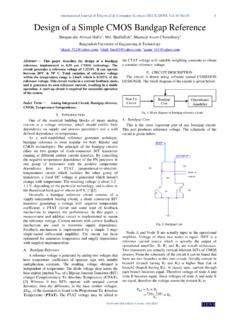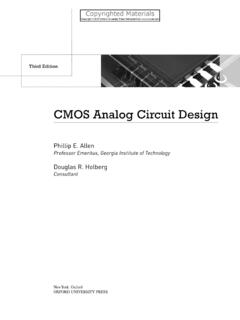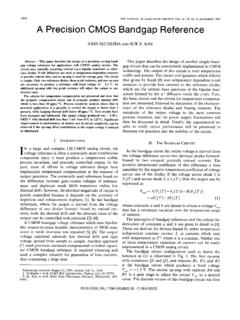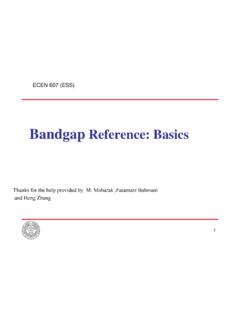Transcription of Design of Analog CMOS Integrated Circuit 2nd Edition ...
1 Razavi-3930640raz24936 FM 00i-xviiiDecember 18, 201510:37iDesign of Analog CMOSI ntegrated CircuitsSecond EditionBehzad RazaviProfessor of Electrical EngineeringUniversity of California, Los AngelesRazavi-3930640raz24936 FM 00i-xviiiDecember 18, 201510:37iiDESIGN OF Analog cmos Integrated CIRCUITS, SECOND EDITIONP ublished by McGraw-Hill Education, 2 Penn Plaza, New York, NY 10121. Copyrightc 2017 by McGraw-HillEducation. All rights reserved. Printed in the United States of America. Previous editionc 2001. No part ofthis publication may be reproduced or distributed in any form or by any means, or stored in a database orretrieval system, without the prior written consent of McGraw-Hill Education, including, but not limited to, inany network or other electronic storage or transmission, or broadcast for distance learningSome ancillaries, including electronic and print components, may not be available to customers outside theUnited book is printed on acid-free 978-0-07-252493-2 MHID 0-07-252493-6 Senior Vice President, Products & Markets:Kurt L.
2 StrandVice President, General Manager, Products & Markets:Marty LangeVice President, Content Design & Delivery:Kimberly Meriwether DavidManaging Director:Thomas TimpGlobal Brand Manager:Raghu SrinivasanDirector, Product Development:Rose KoosProduct Developer:Vincent BradshawMarketing Manager:Nick McFaddenDirector of Digital Content:Chelsea Haupt, Ph. DDirector, Content Design & Delivery:Linda AvenariusProgram Manager:Faye M. HerrigContent Project Managers:Heather Ervolino; Sandra SchneeBuyer:Jennifer PickelContent Licensing Specialists:Lorraine Buczek(Tex t)Compositor:MPS LimitedPrinter:Quad/GraphicsAll credits appearing on page or at the end of the book are considered to be an extension of the copyright of Congress Cataloging-in-Publication DataRazavi, of Analog cmos Integrated circuits / Behzad Razavi, professor of electrical engineering,University of California, Los Angeles.
3 Second cmIncludes bibliographical references and 978-0-07-252493-2 (alk. paper) ISBN 0-07-252493-6 (alk. paper) cmos Integrated circuits. 2. Linear Integrated circuits Design andconstruction. 3. Metal oxide semiconductors, Complementary. I. dc232015035303 The Internet addresses listed in the text were accurate at the time of publication. The inclusion of a website doesnot indicate an endorsement by the authors or McGraw-Hill Education, and McGraw-Hill Education does notguarantee the accuracy of the information presented at these FM 00i-xviiiDecember 18, 201510:37iiiTo the memory of my parentsRazavi-3930640raz24936 FM 00i-xviiiDecember 18, 201510:37ivPreface to the Second EditionWhen I submitted proposals to publishers for the first Edition of this book, they posed two questions tome: (1) What is the future demand for Analog books in a digital world?
4 And (2) Is it wise to publish a bookdealing solely with cmos ? The words Analog and cmos in the book s title were both in , the book resonated with students, instructors, and engineers. It has been adopted byhundreds of universities around the world, translated to five languages, and cited 6,500 many fundamentals of Analog Design have not changed since the first Edition was introduced,several factors have called for a second: migration of cmos technologies to finer geometries and lowersupply voltages, new approaches to analysis and Design , and the need for more detailed treatments ofsome topics. This Edition provides: Greater emphasis on modern cmos technology, culminating in a new chapter, Chapter 11, ondesign methodologies and step-by-step op amp Design in nanometer processes Extensive study of feedback through the approaches by Bode and Middlebrook A new section on the analysis of stability using Nyquist s approach as the oft-used Bode methodfalls short in some common systems Study of FinFETs Sidebars highlighting important points in nanometer Design A new section on biasing techniques Study of low-voltage bandgap circuits More than 100 new examplesSome instructors ask why we begin with square-law devices.
5 This is for two reasons: (1) such a pathserves as an intuitive entry point and provides considerable value in the analysis of amplifiers in terms ofallowable voltage swings, and (2) despite their very short channel lengths, FinFETs the devices usedin 16-nm nodes and below exhibit nearly square-law book is accompanied with a solutions manual and a new set of PowerPoint slides, available RazaviJuly 2015ivRazavi-3930640raz24936 FM 00i-xviiiDecember 18, 201510:37vPreface to the Second EditionvPreface to the First EditionIn the past two decades, cmos technology has rapidly embraced the field of Analog Integrated circuits,providing low-cost, high-performance solutions and rising to dominate the market. While silicon bipolarand III-V devices still find niche applications, only cmos processes have emerged as a viable choice forthe integration of today s complex mixed-signal systems.
6 With channel lengths projected to scale downto m, cmos technology will continue to serve Circuit Design for another two Circuit Design itself has evolved with the technology as well. High-voltage, high-power analogcircuits containing a few tens of transistors and processing small, continuous-time signals have graduallybeen replaced by low-voltage, low-power systems comprising thousands of devices and processing large,mostly discrete-time signals. For example, many Analog techniques used only ten years ago have beenabandoned because they do not lend themselves to low-voltage book deals with the analysis and Design of Analog cmos Integrated circuits, emphasizing fun-damentals as well as new paradigms that students and practicing engineers need to master in today sindustry. Since Analog Design requires both intuition and rigor, each concept is first introduced from anintuitive perspective and subsequently treated by careful analysis.
7 The objective is to develop both a solidfoundation and methods of analyzing circuits by inspection so that the reader learns what approximationscan be made in which circuits and how much error to expect in each approximation. This approach alsoenables the reader to apply the concepts to bipolar circuits with little additional have taught most of the material in this book both at UCLA and in industry, polishing the order, theformat, and the content with every offering. As the reader will see throughout the book, I follow four golden rules in writing (and teaching): (1) I explainwhythe reader needs to know the concept that isto be studied; (2) I put myself in the reader s position and predict the questions that he/she may havewhile reading the material for the first time; (3) With Rule 2 in mind, I pretend to know only as muchas the (first-time) reader and try to grow with him/her, thereby experiencing the same thought process;(4) I begin with the core concept in a simple (even imprecise) language and gradually add necessarymodifications to arrive at the final (precise) idea.
8 The last rule is particularly important in teaching circuitsbecause it allows the reader to observe the evolution of a topology and hence learn both analysis text comprises 16 chapters whose contents and order are carefully chosen to provide a naturalflow for both self-study and classroom adoption in quarter or semester systems. Unlike some other bookson Analog Design , we cover only abare minimumof MOS device physics at the beginning, leaving moreadvanced properties and fabrication details for later chapters. To an expert, the elementary device physicstreatment my appear oversimplified, but my experience suggests that (a) first-time readers simply donot absorb the high-order device effects and fabrication technology before they study circuits becausethey do not see the relevance; (b) if properly presented, even the simple treatment proves adequate for asubstantial coverage of basic circuits; (c) readers learn advanced device phenomena and processing stepsmuch more readilyafterthey have been exposed to a significant amount of Circuit analysis and 1 provides the reader with motivation for learning the material in this book.
9 Chapter 2 describesbasic physics and operation of MOS 3 through 5 deal with single-stage and differential amplifiers and current mirrors, respectively,developing efficient analytical tools for quantifying the behavior of basic circuits by 6 and 7 introduce two imperfections of circuits, namely, frequency response and noise. Noiseis treated at an early stage so that it sinks in as the reader accounts for its effects in subsequent 8 through 10 describe feedback, operational amplifiers, and stability in feedback sys-tems, respectively. With the useful properties of feedback analyzed, the reader is motivated to designhigh-performance, stable op amps and understand the trade-offs between speed, precision, and FM 00i-xviiiDecember 18, 201510:37viviPreface to the Second EditionChapters 11 through 13 deal with more advanced topics: bandgap references, elementary switched-capacitor circuits, and the effect of nonlinearity and mismatch.
10 These three subjects are included herebecause they prove essential in most Analog and mixed-signal systems 14 is concerned with high-order MOS device effects and models, emphasizing the circuitdesign implications. If preferred, the chapter can directly follow Chapter 2 as well. Chapter 15 describesCMOS fabrication technology with a brief overview of layout Design 16 presents the layout and packaging of Analog and mixed-signal circuits. Many practical issuesthat directly impact the performance of the Circuit are described and various techniques are reader is assumed to have a basic knowledge of electronic circuits and devices, ,pnjunctions,the concept of small-signal operation, equivalent circuits, and simple biasing. For a senior-level electivecourse, Chapters 1 through 8 can be covered in a quarter and Chapters 1 through 10 in a semester.





